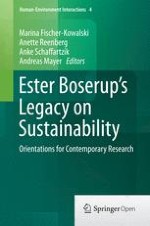8.1 Introduction
8.2 Theoretical Assumptions, Concepts and Methods
8.2.1 Returning to Boserup and Introducing Sociometabolic Concepts
8.2.2 Human Time as a Biophysical Resource
8.2.2.1 Labour Time Studies Revisited
8.3 Description of the Cases
8.3.1 Introducing Trinket, Campo Bello, Sabawas, and Nalang
8.3.2 Methods of Data Collection on Time Use
8.4 Findings
8.4.1 Land and Labour Productivity
8.4.2 Overall Labour Time Investment in the Different Communities
Trinket | Campo Bello | Sabawas | Nalang | |
|---|---|---|---|---|
Forager-Horticulturalist | Shifting cultivation (Short fallows) | Shifting cultivation (Short fallows) | Intensive rice cultivation & shifting cultivation | |
Demographic data
| ||||
Population (cap) | 399 | 231 | 290 | 702 |
Community area (ha) | 3,626 | 615 | 652 | 1,630 |
Population density (cap/ha) | 0.11 | 0.38 | 0.44 | 0.43 |
Population growth (%/a) | 1.5 | 3.8 | 2.5 | 3.0 |
Share of population below age 15 (%) | 39 | 61 | 55 | 45 |
Food production and consumption
| ||||
Food production (GJ/a) | 2,820 | 1,840 | 2,792 | 3,752 |
Food consumption (GJ/a) | 1,752 | 940 | 1,383 | 3,320 |
Nutritional energy from agriculture (%) | 30.7 | 84 | 84.5 | 92.6 |
Nutritional energy from F/H/G (%) | 69.3 | 16 | 15.5 | 7.4 |
Staple food production (SFP)
| ||||
Area for SFP incl. fallow (ha) | 29 | 200 | 238 | 139 |
Share of area for SFP (%) | 1 | 33 | 37 | 9 |
Labour hours for SFP (1,000 h/a) | 25 | 114 | 153 | 213 |
Fossil energy input per Area (GJ/ha) | 0 | 0 | 0 | 1.2 |
Average Adult 16–60 (h/d) | ||||
|---|---|---|---|---|
Trinket | Campo Bello | Sabawas | Nalang | |
Total population size | 399 | 231 | 290 | 702 |
Population size 16–60 | 244 | 91 | 121 | 356 |
Person System (PS)
|
18.45
|
13.21
|
13.00
|
14.34
|
Household system (HS)
|
3.23
|
3.79
|
3.70
|
3.68
|
Care for dependents | 0.00 | 1.59 | 1.50 | 0.46 |
Food preparation | 1.09 | 1.07 | 1.00 | 0.69 |
House building | 0.00 | 0.26 | 0.25 | 1.43 |
Repair/maintenance work | 0.16 | 0.34 | 0.35 | 0.00 |
Domestic chores | 1.98 | 0.64 | 0.60 | 1.10 |
Economic system (ES)
|
1.19
|
4.69
|
4.75
|
5.85
|
Agriculture/horticulture | 0.07 | 2.32 | 2.25 | 3.06 |
Hunting | 0.00 | 0.46 | 0.45 | 0.00 |
Fishing | 0.58 | 0.35 | 0.30 | 0.44 |
Gathering | 0.00 | 0.17 | 0.20 | 0.15 |
Trading | 0.39 | 0.43 | 0.45 | 0.00 |
Wage work | 0.00 | 0.27 | 0.25 | 1.46 |
House garden | 0.02 | 0.21 | 0.25 | 0.00 |
Handicraft | 0.00 | 0.41 | 0.40 | 0.13 |
Animal husbandry | 0.14 | 0.02 | 0.20 | 0.61 |
Community system (CS)
|
1.13
|
2.32
|
2.55
|
0.12
|
Annual labour time ES (h/a) |
434
|
1,711
|
1,733
|
2,135
|
Daily labour time HS + ES (h/d) |
4.42
|
8.48
|
8.45
|
9.54
|
8.4.2.1 Gender Differences in Labour Time
Trinket | Campo Bello | Sabawas | Nalang | |||||||||
|---|---|---|---|---|---|---|---|---|---|---|---|---|
Male adults 16–60 | Female adults 16–60 | Boys 6–15 | Girls 6–15 | Male adults 16–60 | Female adults 16–60 | Boys 6–15 | Girls 6–15 | Male adults 16–60 | Female adults 16–60 | Male adults 16–60 | Female adults 16–60 | |
Household system (HS) | 1.2 | 6.9 | 1.8 | 2.9 | 1.1 | 6.8 | 0.8 | 1.5 | 1.1 | 6.3 | 2.9 | 4.4 |
Economic system (ES) | 2.4 | 0.0 | 2.6 | 2.6 | 5.8 | 3.5 | 2.7 | 2.4 | 5.9 | 3.6 | 5.6 | 6.1 |
Daily labour time HS + ES
|
3.6
|
6.9
|
4.4
|
5.5
|
6.9
|
10.3
|
3.5
|
3.9
|
7.0
|
9.9
|
8.5
|
10.5
|
8.4.2.2 The Contribution of Children to Labour Time
Trinket | Campo Bello | Sabawas | Nalang | |
|---|---|---|---|---|
Population size | 399 | 231 | 290 | 702 |
Population growth (cap/a) | 1.5 | 3.8 | 2.5 | 3 |
Number of children below 15 | 155 | 137 | 159 | 318 |
Share of population below 15 (%) | 39 | 59 | 55 | 45 |
Children’s share in the total community labour time investment (%) |
39
|
61
|
51
|
45
|
Campo Bello | Sabawas | |||
|---|---|---|---|---|
Boys 6–15 | Girls 6–15 | Boys 6–15 | Girls 6–15 | |
Household system (HS)
|
1.8
|
2.9
|
0.8
|
1.5
|
Care for dependents | 0.5 | 1.5 | 0.2 | 0.6 |
Food preparation | 0.2 | 0.5 | 0.0 | 0.3 |
House building | 0.0 | 0.0 | 0.1 | 0.0 |
Repair/maintainance work | 0.2 | 0.2 | 0.2 | 0.2 |
Domestic chores | 0.9 | 0.7 | 0.3 | 0.4 |
Economic system (ES)
|
2.6
|
2.6
|
2.7
|
2.4
|
Agriculture/horticulture | 0.8 | 0.2 | 0.8 | 0.3 |
Hunting, fishing and gathering | 1.1 | 1.5 | 1.2 | 1.6 |
Trading | 0.0 | 0.3 | 0.0 | 0.0 |
Handicraft | 0.6 | 0.4 | 0.5 | 0.3 |
Animal husbandry | 0.1 | 0.2 | 0.2 | 0.2 |
Daily labour time HS + ES
|
4.4
|
5.5
|
3.5
|
3.9
|
